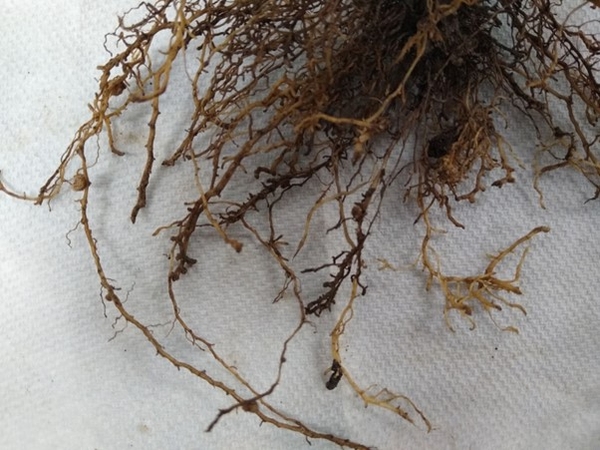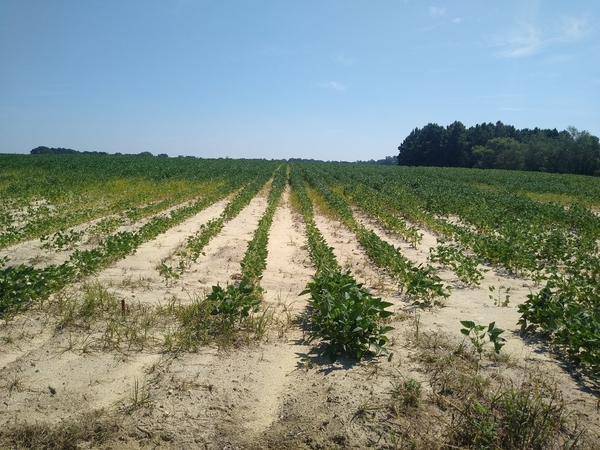Introduction
Soybean is a major crop grown throughout North Carolina and is important for oil, food, and animal feed. Fortunately, sting nematodes are only a concern for a small percentage of soybean acreage, limited to areas of North Carolina where sandy soils occur (>80% sand). Yet when present, they have the potential to inflict serious damage and significant crop loss even at low population densities.
Recall that not all nematodes inhabiting the soil of soybeans are plant-parasitic; thus, not every soil-dwelling nematode poses a threat. Free-living nematodes, or non-parasitic nematodes, can contribute positively to soybean growth by decomposing organic matter and preying on other pathogens and pests. Given their microscopic nature and their existence as either plant-parasitic or free-living nematodes, detecting and identifying nematodes accurately and effectively is important.
Pathogen
Around the world, there are nine distinct species in the Belonolaimus genus of sting nematode: B. anama, B. gracilis, B. jara, B. lineatus, B. lolii, B. longicaudatus, B. maritimus, B. nortoni, and B. euthychilus.
Among the nine species, Belonolaimus longicaudatus is the most prominent species found throughout the Southeastern United States since it thrives in sandy soils. Outside of the United States, B. longicaudatus has also been found in Barbados, the Bahamas, Bermuda, California, Costa Rica, and Mexico (Bridge and Starr 2007; McGregory et al. 2020).
Sting nematode is worm-like (vermiform) throughout its life cycle. The nematode cannot be visualized with the unaided eye, unlike root knot nematode or soybean cyst nematode, and requires a microscope for identification.
Disease Cycle
The lifecycle of sting nematodes typically spans about 28 days. Sting nematodes are ectoparasites, meaning they do not establish permanent, fixed feeding sites, but rather migrate from root to root, feeding as they go (Perrine-Walker 2019). Sting nematode thrives in sandy soils in the southeastern United States where the sand content is typically greater than 80% (Huang and Becker 1999).
Sting nematodes begin as tic-tac-shaped eggs and molt into second-stage juveniles (J2) while still in the egg. The J2s hatch from the eggs (Fig 1 A) and begin to feed on root tips or root hairs, lasting between 12 to 24 hours until they become immobile in a “C” position during this stage. The second molting period begins, and the now third-stage juveniles begin feeding again. Additional molting and feeding stages occur through the fourth stage juveniles and finally to the adult stage (Fig. 1 B, C). Sting nematodes require sexual reproduction to reproduce and a host to continue their life cycle.
Symptoms
Below-ground symptoms
Sting nematodes are parasitic to plants and they feed on the tips of roots, which cause roots to appear stubby and short. Root tips may also become blackened with signs of rotting (Fig 2). Higher densities of sting nematodes can completely devastate root systems (Crow and Han 2005).
Above-ground symptoms
Identifying sting nematode in soybean by looking at above ground parts of the plant may be challenging since the symptoms observed in the foliage often mimic those of nutrient deficiencies and/or drought stress. These symptoms may include stunting, wilting, chlorosis, yield reduction, and plant death (Fig 3). Other symptoms include irregular patches and an increase in weed growth. In severe cases, extensive infestations can even result in crop decline and death.
Diagnosis
Identifying if a field has a sting nematode infection is the first step in developing a management plan. Noting any aboveground symptoms, especially early in the growing season, is important for diagnosing the problem. However, once symptoms appear, it may be too late to initiate management tactics to protect the current crop and management for future crops should be considered. Sting nematode may cause considerable damage in soybean and other crops, even at very low population numbers. Early diagnosis and active management of sting nematode can ensure fields remain productive for many years.
In order to properly diagnose a sting nematode issue, soil and roots must be sampled and analyzed by a professional diagnostic laboratory or nematode assay laboratory. Soil samples for nematode assay services may be taken and sent to North Carolina Department of Agriculture & Consumer Services, Agronomic Services (NCDA&CS), Nematode Assay Laboratory, 4300 Reedy Creek Road, Raleigh, NC 27607.
In order to determine nematode pressure, soil samples should be collected from several areas in the affected field. Using a soil probe, collect 20 soil cores across a 5-acre block, at a depth of 6 to 8 inches from each area using a grid-like pattern or a zig-zag pattern across the field. For evaluating sting nematode, it is particularly helpful to sample from plants in the “transition zone” between heavily affected areas and seemingly healthy areas. Combine soil cores in a clean plastic bucket and remove a smaller portion of soil from this larger sample to submit to the Nematode Assay Laboratory. More detailed sampling instructions can be found at the NCDA&CS Nematode Assay Laboratory sampling guidelines.
Management
Sting nematode has a low economic threshold, that is, the number of nematodes that may be tolerated before crop damage and yield loss is suffered. Therefore, if a field is known to have a sting nematode problem, management actions should be taken to reduce its impact on the crop. Review your nematode assay report to evaluate each nematode's population density and soybeans' risk level.
Integrated pest management (IPM) is a “toolbox approach” used to reduce disease pressure and populations of pest organisms by using several disease management tactics, including cultural, mechanical, biological, and chemical control. Rotating the use of and/or combining management tactics lessens reliance on a single tactic and minimizes the costs and risks of developing resistance to a single pesticide.
Cultural
Cultural management is modifying the environment or certain production practices to reduce the pest population.
- Rotate to non-host crops of sting nematode (B. longicaudatus), such as sweetpotato and sunn hemp (Grabau et al. 2022), to reduce populations by withholding a suitable host. Table 1 provides a list of known host and non-host plants to sting nematode (B. longicaudatus).
- Consider a fallow treatment for heavily infested areas. Sting nematodes have no long-term survival stage, so populations decline rapidly when a field is fallow or a non-host crop is planted.
- Sanitize equipment and tools by removing infested soil stuck to equipment with a solution of 10% household bleach and rinsing with clean water before drying. This prevents transfer of soil potentially infested with sting nematode to new areas.
- Sting nematodes can also infect, reproduce, and survive on common weeds. Good weed management will eliminate a potential food source for these nematodes.
| Crop Type | Host Plants |
|
Fruits and Vegetables |
Bush bean, Cabbage, Cantaloupe, Carrots, Cauliflower, Celery, Cowpea, Citrus, Cucumber, Eggplant, Endive, Lettuce, Lima bean, Okra, Onion, Pea, Radish, Snap bean, Squash, Strawberry, Sweet corn, Sweetpotato, Spinach, Tomato, Turnip |
|
Field crops |
Corn, Cotton, Lupine, Peanuts, Sorghum, Soybean |
|
Grasses and grains |
Annual bluegrass, Barley, Bermudagrass, Italian ryegrass, Kentucky bluegrass, Pearl millet, Perennial ryegrass, Rye, Sorghum Sudangrass, Tall fescue, Western wheatgrass, Wheat |
|
Common Weeds |
Black nightshade, Crabgrass, Lambsquarters, Prostrate pigweed, Purple nutsedge, Purslane, Shepherdspurse, Smutgrass, Wild mustard, Yellow nutsedge |
|
Crop Type |
Non-Hosts Plants |
|
Field Crops and cover crops |
Crotalaria, Hairy Indigo, Sunn hemp, Tobacco, Velvet bean, |
|
Fruits and Vegetables |
Asparagus, Hot pepper, Sorrel, Watermelon |
|
Common Weeds |
Buckhorn plantain, Cocklebur, Horseweed, Jerusalem oak, Jimson weed, Pokeweed, Sandbur, Wild garlic |
Mechanical
Mechanical management tactics use physical means to block or destroy nematode pathogens.
- Disking or working the field several times before planting can reduce nematode numbers through the abrasive action of soil particle movement on the nematode bodies.
- When smaller areas need to be treated with non-chemical means, soil solarization may be viable. In this technique, clear plastic sheets are laid and sealed over the soil to raise the temperature of the soil using a greenhouse effect, which effectively kills disease-causing organisms in the soil. More information about soil solarization can be found in the University of California’s handbook.
Biological and Chemical
Biological and chemical management uses nematicidal compounds to reduce populations of the nematode. Nematicides can be used to manage sting nematodes in soybeans, where economically viable, with the goal of reduce sting nematode population levels to below yield-impacting levels. Chemical and biological nematicide products labeled for use in soybean in North Carolina are listed in Table 2 and additional information may be found in the North Carolina Agricultural Chemicals Manual.
While using chemicals to manage pathogens and pests is effective, there may be unintended effects, such as phytotoxicity to the crop or residual toxicity to the environment. It is imperative to follow the label to minimize these risks.
|
Active ingredient and formulation |
Amount |
Notes |
|
Aldicarb (AgLogic) |
5.0 – 7.0 lbs/ac |
Apply a 4-6 inch band in furrow. See stewardship requirements. |
|
abamectin (Avicta Beans 500) |
0.15 mg per seed |
Seed treatment |
|
clothianidin 40.3% + Bacillus firmus I-1582 8.1% (Poncho/Votivo) |
0.25 to 0.50 mg per seed |
Seed treatment |
|
Bacillus amyloliquefaciens Strain PTA-4838 16.5% (Aveo EZ) |
0.1 fl oz per 80,000 seed |
Seed treatment |
|
Pydiflumetofen (Saltro) |
0.714 fl oz per 140,000 seed |
Seed treatment |
Additional Resources
The NCDA&CS Nematode Assay Lab provides soil detection and diagnostics
The NCSU Plant Disease and Insect Clinic provides diagnostic and management recommendations.
The NC State Extension Plant Pathology portal provides information on crop disease management
The Southeastern US Vegetable Crop Handbook provides information on vegetable disease management
The North Carolina Agricultural Chemicals Manual provides an up-to-date list of chemicals available for control of nematodes and other diseases and pests
Acknowledgements
This factsheet was prepared by the NC State University Field Crops and Tobacco Pathology Lab in 2020
This factsheet was updated by the NCSU Plant Nematology Lab in 2024.
References
Publication date: Sept. 9, 2020
Reviewed/Revised: June 18, 2025
N.C. Cooperative Extension prohibits discrimination and harassment regardless of age, color, disability, family and marital status, gender identity, national origin, political beliefs, race, religion, sex (including pregnancy), sexual orientation and veteran status.
NC Cooperative Extension prohíbe la discriminación por raza, color, nacionalidad, edad, sexo (incluyendo el embarazo), discapacidad, religión, orientación sexual, identidad de género, información genética, afiliación política, y estatus de veteran.
The use of brand names in this publication does not imply endorsement by NC State University or N.C. A&T State University of the products or services named nor discrimination against similar products or services not mentioned.
Recommendations for the use of agricultural chemicals are included in this publication as a convenience to the reader. The use of brand names and any mention or listing of commercial products or services in this publication does not imply endorsement by NC State University or N.C. A&T State University nor discrimination against similar products or services not mentioned. Individuals who use agricultural chemicals are responsible for ensuring that the intended use complies with current regulations and conforms to the product label. Be sure to obtain current information about usage regulations and examine a current product label before applying any chemical. For assistance, contact your local N.C. Cooperative Extension county center.
N.C. Cooperative Extension prohibits discrimination and harassment regardless of age, color, disability, family and marital status, gender identity, national origin, political beliefs, race, religion, sex (including pregnancy), sexual orientation and veteran status.



